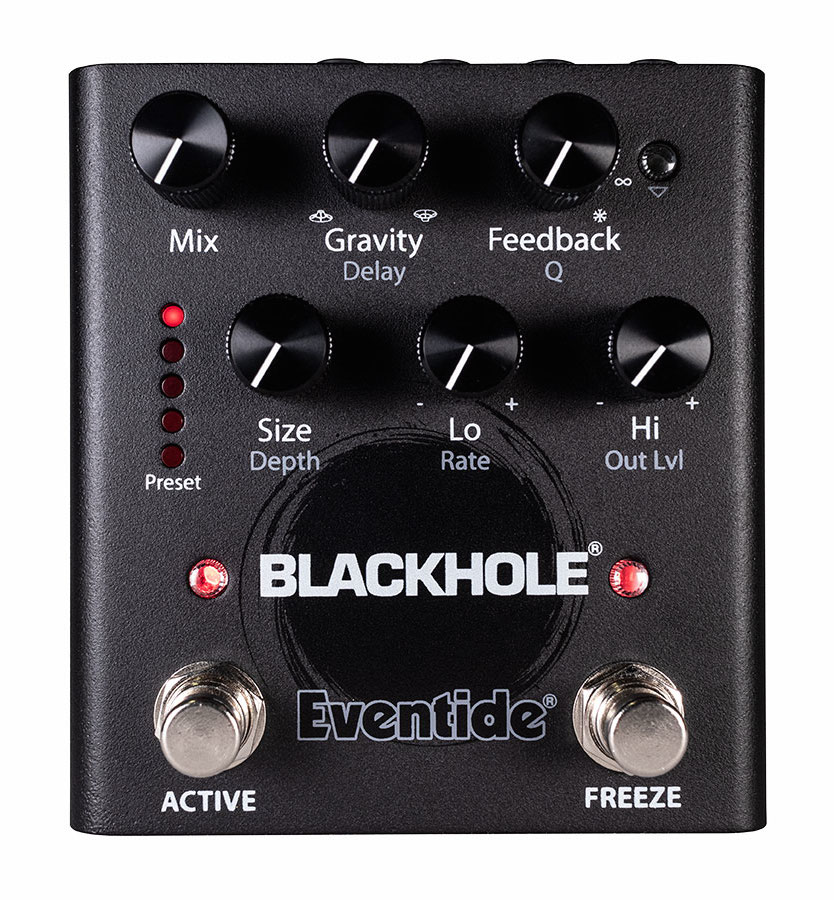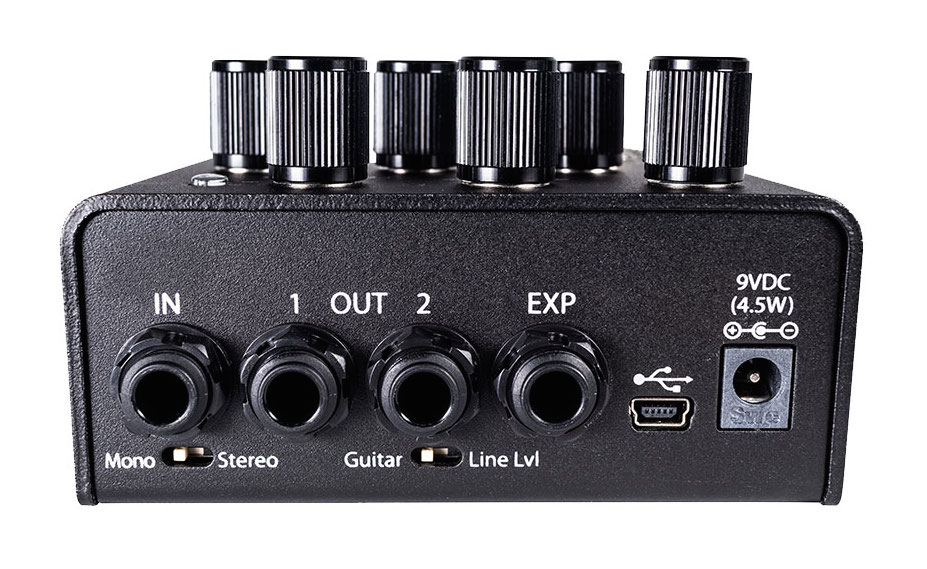New Gear Review: Blackhole Pedal by Eventide

Eventide ports their Blackhole algorithm over to stompbox form—with added flexibility to boot. Should this pedal earn a spot on your board?
No guitarist’s pedalboard is complete without a reverb pedal. An added sense of space is integral to any well-rounded string instrumentalist’s sound palette, whether you’re a pro on stage in front of thousands, or a weekend warrior at the local watering hole.
Eventide has no shortage of offerings to take your guitar or bass tone to the next level. Whether it’s their expansive line of individual, purpose-built pedals, or their revolutionary H9 Harmonizer all-in-one solution, there likely isn’t an effect under the sun Eventide can’t conjure.
The company has made their popular Blackhole algorithm available in several forms, whether inside the H9 hardware, in plugin format for your DAW, in iOS format for your tablet or smartphone… and now as a proper standalone stompbox. With reverb as a necessary tool for any complete guitar setup, can the Blackhole Pedal fulfill all your space-based tonal needs and become your go-to reverb?
Features
The Blackhole, first and foremost, is a sexy looking pedal, and its matte black metal enclosure feels robust and road-ready. It ships with a 9v power supply, complete with adapters for international travel, as well as the thoughtful inclusion of four rubber feet if the Blackhole’s fate is not to be velcro’d down to a pedalboard. A guitar pick bearing the Eventide name is even included.
The connectivity options found on the back of the Blackhole are comprehensive. Being primarily a producer and mixer, it’s more likely this pedal will be used in a re-amping or hardware insert context in my studio rather than on a pedalboard, and to that end, the Blackhole delivers.
Its singular input jack functions both as a mono TS and stereo TRS input, selectable via a small horizontal recessed switch directly below. There are stereo output jacks, and another recessed switch below these which is selectable for either instrument or line level signals—again, crucial in my studio application. The EXP jack, as you would expect, is for an expression pedal, but also offers aux switching and TRS MIDI functionality. Lastly, there is a 9v power input with negative center pin, and a mini USB input for software updates and MIDI over USB from controllers with MIDI host capabilities.
Six knobs, two push-button LEDs, and two soft-click switches adorn the faceplate of the pedal. The knobs have a nice resistance to them when turned, further bolstering the Blackhole’s feeling of high quality construction. The knobs on the pedal read Mix, Gravity, Feedback, Size, Lo, and Hi. There are also secondary functions available for some of these knobs via the click of a button/LED in the upper right-hand corner, which when illuminated indicates you are in secondary mode.
The Mix control is your standard wet/dry mix. The Gravity knob, when turned to the right provides a normal decay; when turned to the left, the decay is inverted (more on this later). The Gravity knob also has a secondary function for Delay. The Feedback control functions as expected, however at the “infinity” position (indicated by the ∞ icon) you reach infinite decay, and at fully clockwise it functions in Freeze mode, with the dry signal passing as set by the Mix control. Feedback, as well, functions secondarily as a Q control for any EQ applied on the Blackhole (more on that soon).
There is a self-explanatory Size knob which offers a secondary function for Depth. To its right is a knob labeled Lo which acts as a boost/cut for frequencies below 350Hz and also features a secondary function for Rate. And lastly, the Hi knob serves as a boost/cut for frequencies above 2kHz, with a secondary function for Output Level.
The footswitch labeled Active on the Blackhole acts as a bypass, with a button/LED above it; when lit, this indicates the pedal is engaged, and when pressed, enables this switch to toggle between latching and momentary modes. The second footswitch is labeled Freeze, which when held, enables you to toggle between presets, of which there are five available onboard and 127 via MIDI. This switch as well has a button/LED above which when lit, indicates Freeze is engaged, and when pressed and held, saves presets, which are indicated by a five-segment LED ladder on the left-hand side of the pedal.
So with this popular and powerful reverb algorithm now available in tactile form—and with these added hardware benefits—let’s see if the Blackhole can become a permanent fixture in my setup.
In Use
Off the bat, and as its name would imply, the Blackhole is not a small-sounding reverb. After just a few moments of first-use experimental knob-tweaking, it’s clear the sound of the pedal is quite literally—and I mean this as a positive—abysmal. Increasing the Size and utilizing the Freeze function can produce long and droning echoes which can only be further stylized with use of the onboard EQ shelves, Rate, Delay, and manipulation of the Size knob to create rises and falls.
It didn’t take long to realize that the Gravity control is probably the most unique sonic feature on offer here, as settings counter-clockwise of noon produce a sort of reverse reverb effect—but with a twist I can’t quite describe with words; it’s not the same as creating a reverse reverb in a DAW. This distinctive and stylish sonic footprint is likely to set the Blackhole aside from the other, more traditional reverbs available on the market.
The ability to use the Blackhole in stereo and line level mode is crucial for users like myself who will primarily have it set atop a desk in the studio rather than on a pedalboard. From my DAW I ran some drums and vocals through the pedal to see how it fared in these less traditional applications.
After some experimentation, I wouldn’t say the Blackhole would become one of my go-to drum or vocal reverbs (I didn’t expect it to be), but it would certainly be a contender for tasty effects and throws on these particular sources. The ability for a studio user like myself to get my hands on a tactile desktop reverb that I can use for creative moves, and even to inspire new sounds, is a welcome addition to my workflow.
The Blackhole was super fun on synths as well, especially sounds that harkened back to 80s JUNO-type flavor. Creating long drones and sound beds with just a single note from a keyboard (or guitar or bass, for that matter), was one of the many places that the Blackhole excelled.
And though using reverb with bass doesn’t happen often here, it does happen. To this end, the Blackhole held its own. If I were in need of a subtle bass reverb effect, a more conservative setting on the Blackhole with the Mix knob highly in favor of the dry signal is sure to produce usable results. If I were in need of a brighter, smaller, and more reflective space (which is often the case for bass verb), perhaps I wouldn’t reach for the Blackhole. But for subtle, non-focal applications, this pedal can surely handle the task.
With longer drones that benefit from some modulation, the secondary controls proved useful. I would say that it’s highly likely the next time I create a single-note sound bed with some textural movement over a large number of measures, the Blackhole will the first tool I reach for.
To Be Critical
With regard to the pedal not producing a “small” sound: if you’re looking for the tonal qualities of a tight, small, reflective room, studio, or chamber, Blackhole is probably not the appropriate choice here. But that’s not to say this pedal isn’t capable of creating an unobtrusive and subtle reverb. Simply dial in modest Feedback and Size settings, with the Gravity set somewhere clockwise of noon, and adjust your Mix setting to taste.
And although it’s much appreciated the Blackhole can run in stereo mode, having only a TRS option for input here is a slight inconvenience. That said, I understand Eventide cutting costs with the omission of a fifth jack on the back as the Blackhole will more than likely reside on pedalboards and not studio desks.
Summing it Up
The sonic footprint of the Blackhole is exactly as its name suggests. With its ability to create seemingly endless deep and dark throws, and the signature time-warping effect of the Gravity control, it will be hard to mistake the sound of this pedal for anything else. It can find its home on your pedalboard or atop your studio desk for $279.
If you’re looking for a versatile reverb that can emulate a variety of spaces, the Blackhole may not be the reverb for you. However, if you’ve got your basics covered and your reverb arsenal can use a unique and powerful new twist, the Blackhole may be just the right choice.
Please note: When you buy products through links on this page, we may earn an affiliate commission.







